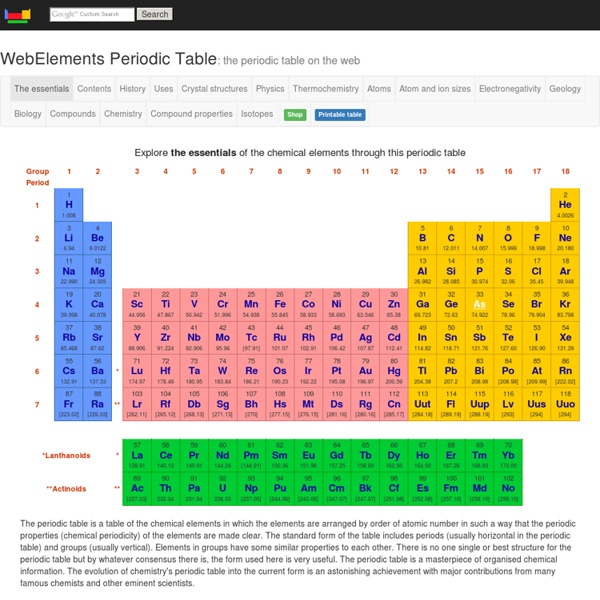Periodic Table

CLEAPSS
Periodic Table of Elements and Chemistry
Christmas science projects | Young Science Explorers
In this issue: Crystal Snowflake ProjectFrosted Window Panes ProjectFun FactsSilly ScienceWay Cool WebsitesScience WordsPrintable pdf Are you dreaming of a white Christmas? Christmas Crystals You've probably seen lots of crystals—even if you don't know it! Paper Snowflake Crystal Ornament Science Project What you need: filter paper (or coffee filters)sodium tetraborate (Borax)water600 ml beaker (or other glass container)stirring rod (or spoon)scissorspetri dishes (or plate)fishing line (or string) What you do: Make a supersaturated solution of Borax and water by having an adult help you use the microwave to heat about 200 ml of water until boiling. Way Cool Websites Make various paper snowflakes with these folding and cutting directions! Fabulous Facts Crystal colors depend on the minerals that created them and the how their atoms absorb light.Snowflakes start as ice crystals the size of a speck of dust that join other crystals to form snowflakes. Silly Science The letter "D!" Knock knock.
Doc Brown's (chemistry teacher) GCSE Science Biology Physics HOMEPAGE Revision Notes Quizzes e-learning website free to use online
Related:
Related:




Dont forget the group number tells you how many electrons are in the outer shell
So elements in the same group have similar chemical properies
The period tells you how many shells the atom has.
The smaller number is the atomic number this tells you how many protons are in an atom of that element
The number of protons cannot change. eg Carbon ALWAYS has 6 protons
The larger number is the mass number this tells you how many protons + neutrons are in an atom of that element
(So to work out the number of neutrons take the big number from the little number)
This table shows the mass number with lots of decimal places. In one atom you can't have a quarter of a neutron. This is an average number. because they can have different nubers of nuetrons without affecting its properties (these are called isotopes) by s.burgham Jun 23